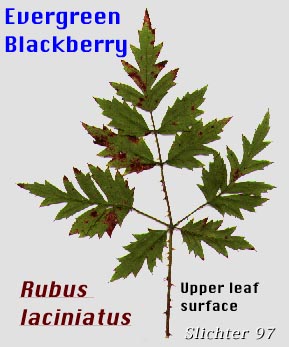



The evergreen blackberry is an erect and spreading shrub, armed with prickly stems to 12 meters long. The stems are thin (about 1.5 cm thick), reddish green, and have many downward pointing prickles which curve more than those of Himalayan blackberry. The leaves are palmately compound with deeply incised leaflets. The terminal leaflet may be further parted. The leaves are dark green above, and gray-green and partially hairy below. The 3-5 leaflets have many prickles on the veins of the lower surface.
The flowers are white with 5 petals. The petals are 9-14 mm long. There are usually more than 75 stamens on each flower. The fruits are black with many hard seeds.Although it is a weedy, invasive species, it provides food and shelter for many smaller birds and mammals. However, like its more abundant cousin, the Himalayan blackberry, it probably does more damage by suppressing or killing the growth of many native plants. The fruits of the evergreen blackberry are edible, but much more seedy than those of the Himalayan blackberry.
Evergreen blackberry is an invasive species of disturbed upland sites which get bright sunlight. It may often be found growing along fence rows, roadsides, railroad grades, and in disturbed pastures.
Evergreen blackberry is a native of Eurasia which has escaped cultivation in North America. It may be found from British Columbia south to California. It is most prominent west of the Cascades.